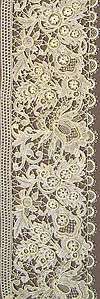Leavers machine

The Leavers machine is a lacemaking machine that John Levers adapted from Heathcoat's Old Loughborough machine. It was made in Nottingham in 1813. The name of the machine was the Leavers machine (the 'a' was added to aid pronunciation in France). The original machine made net but it was discovered that the Jacquard apparatus could be adapted to it. From 1841 lace complete with pattern, net and outline could be made on the Leavers machine. The Leavers machine is probably the most versatile of all machines for making patterned lace.[1][2] A 120 inches (300 cm) machine will weigh 17 tons and have 40,000 moving parts and carry between 12,000 and 50,000 threads. Working widths are always multiples of 9 inches (230 mm) since the web is calculated in quarter yards.[3]
History
All lace machines stem from the Stocking frame, and in this case, its derivative Heathcoat's Old Loughborough of 1808. The Leavers machine was invented by John Levers, a framesmith and setter-up of Sutton-in-Ashfield. Sources give the date as either 1813 or 1814, and the location as Derby Road, Nottingham. Patent applications up until 1930, spelled the name the name without an 'a', but about 1906, foreign sources had started to insert an 'a'. The Lace working party of 1946 decided to adopt an 'a' and the trade association henceforth adopted that spelling.[4].
In 1828 an improvement was made to drive the bobbin carriage at intervals, thus leaving time for 'shogging' the guidebars between each movement. In 1841 use of a knob Jacquard allowed the insertion of thick thread (liner). The knobs allowed a greater distance and allowed the automatic gimping around flowered pattterns.[5].
The number of Leavers in use was dependent on the market and during periods of depression or cotton shortage many frames were broken up for their iron content. The use of Raschel machines, noted for being better for artificial fibres increased in the 1970s and, with fine polyesters, the two products have converged.[6]
References
Notes
- ↑ Farrell 2007.
- ↑ Earnshaw 1986, pp. 107-172.
- ↑ Earnshaw 1986, p. 107.
- ↑ Earnshaw 1986, pp. 107,108.
- ↑ Earnshaw 1986, pp. 108,109.
- ↑ Earnshaw 1986, pp. 110.
Bibliography
- Earnshaw, Pat (1985). The Identification of lace. De Bild:Cantecleer. ISBN 9021302179.
- Earnshaw, Pat (1986). Lace Machines and Machine Laces. Batsford. ISBN 0713446846.
- Farrell, Jeremy (2007). "Identifying Handmade and Machine Lace" (PDF). DATS (Dress and Textile Specialists) in partnership with the V&A.
- Felkin, William. A history of the machine-wrought hosiery and lace manufacturies. Longmans, G.Keen, and co. 1867.
